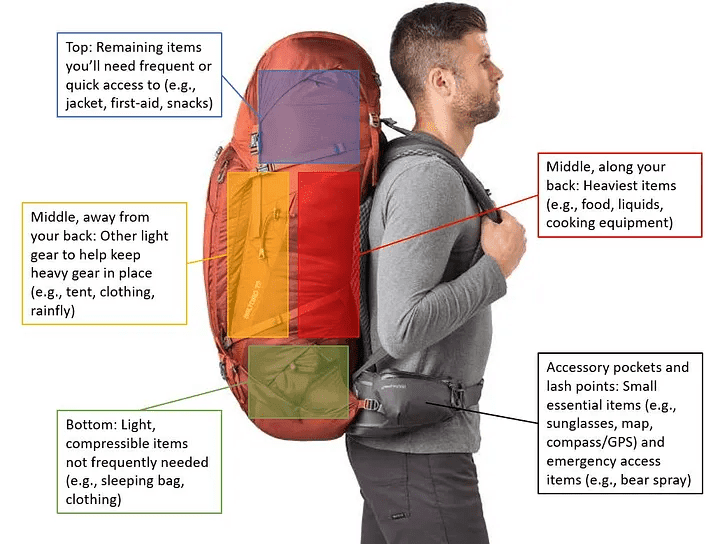Hey there, backpack enthusiasts! Let’s talk about everyone’s favourite school sidekick: the backpack. You know, those trusty companions that carry our books, gadgets, and snacks make school life much easier.
But hold on a sec – have you ever stopped to think about backpack safety?
Yep, it’s a thing! How you wear and pack your backpack can make a big difference in keeping you comfy and healthy.
So, in this little journey together, we’ll explore the wonderful world of backpack safety. Think of it as your guide to rocking that backpack while keeping your back happy.
Trust us, it’s not rocket science – just simple tips and tricks to ensure you’re strutting down the school halls with style and ease.
Tips for Proper Backpack Use: Ensuring Comfort and Safety for Children and Teens

Backpacks are essential companions for students, but improper usage can lead to discomfort and potential health issues. Here are some guidelines to help your family use backpacks safely:
Choose the Right Backpack:
When selecting a backpack, prioritise appropriateness for your child’s size and needs. Opt for one with the following features:
- Wide, padded shoulder straps: These distribute weight evenly and reduce strain on the shoulders.
- Two shoulder straps: Using both straps helps balance the weight and prevents muscle strain.
- Padded back: A cushioned back panel adds comfort and provides additional support.
- Waist strap: This helps distribute weight evenly across the body and prevents the backpack from swinging.
- Lightweight design: Choose a backpack made of lightweight materials to minimise the overall load.
- Consider a rolling backpack: Especially beneficial for students with heavy loads, rolling backpacks reduce the strain of carrying weight on the back.
Proper Weight Distribution:
- Encourage your child to pack their backpack thoughtfully, distributing heavier items evenly and placing lighter items towards the front. Aim to keep the total weight of the backpack at a manageable level, ideally no more than 10-15% of the child’s body weight.
Wearing the Backpack Correctly:
- Emphasise the importance of wearing the backpack properly:
- Use both shoulder straps, adjusting them to fit comfortably.
- Ensure the backpack sits snugly against the back, with the bottom resting at the waist level.
- Tighten the waist strap if available, to stabilise the backpack and prevent it from shifting.
Limiting Backpack Weight:
- Encourage your child to periodically clean out their backpack and remove unnecessary items. Promote organisation by using folders or compartments to separate and distribute weight evenly.
Promoting Posture Awareness:
- Educate your child about the significance of good posture while carrying a backpack. Encourage them to stand up straight and avoid leaning forward or slouching under the weight of the backpack.
By following these simple guidelines, you can help your child enjoy the benefits of a backpack while minimising the risk of discomfort or injury. Remember, a properly used backpack can be a valuable tool in supporting your child’s educational journey.
Tips for Backpacking and Hiking

Embarking on a hiking adventure is an opportunity, but it requires careful planning and preparation, particularly when it comes to selecting and utilising your backpack.
Here are some good tips to ensure a safe and enjoyable hike:
Select the Appropriate Backpack:
It’s important to choose a backpack that suits your hiking needs and personal preferences. Look for one with adjustable straps, cushioned hip belts, and multiple compartments for organisation. Make sure it fits comfortably and can accommodate all your gear without feeling too cumbersome.
Travel Light and Smart:
Keep your backpack as lightweight as possible by packing only the essentials. Prioritise items such as water, snacks, a first aid kit, navigation tools, extra clothing layers, and emergency supplies.
To ensure balance and stability, evenly distribute the weight throughout the backpack.
Consider the Terrain and Duration:
mise your backpacking gear based on the specific terrain and length of your hike. For longer journeys or rough terrain, opt for a backpack with a larger capacity and sturdy construction. Conversely, for shorter day hikes on well-marked trails, a smaller, lighter backpack may suffice.
Ensure Proper Fit and Adjustment:
It’s crucial to ensure that your backpack fits properly and securely against your back. Adjust the shoulder straps, hip belt, and load lifters to distribute the weight evenly and minimise strain on your shoulders and back. Experiment with different adjustments until you find the most comfortable fit.
Distribute Weight Strategically:
Arrange your gear in the backpack so that heavier items are positioned closer to your back and towards the centre. This will help maintain your balance and stability while hiking, reducing the risk of strain or injury. Utilise compression straps to secure the load and prevent shifting.
Stay Hydrated and Fueled:
Bring enough water and energy-rich snacks to stay hydrated and energised during your hike. Think about getting a hydration bladder or water bottle that’s easily accessible to keep yourself refreshed while on the go.
Practise Proper Hiking Technique:
Maintain good posture and a steady stride while hiking to minimise stress on your muscles and joints.
Make sure to take frequent breaks to rest, stretch, and refuel. Pay attention to your body’s signals and adjust your pace accordingly to prevent overexertion.
Leave No Trace:
Respect the natural environment and leave it as you found it. Dispose of all trash properly, stay on designated trails, and minimise your impact on wildlife and vegetation.
By leaving no trace, you help preserve the beauty of the wilderness for the next generations to enjoy.
Preventing Backpack-Related Injuries:
Tips for Safe Carrying Incorporating simple habits into your routine can make a big difference and prevent injuries associated with backpack use.
Here’s what you can do:
Use Both Shoulder Straps:
Always opt for using both shoulder straps when carrying a backpack. This distributes the weight evenly across the back, reducing strain. Ensure the straps are wide and well-padded for added comfort.
Properly Adjust Straps:
Tighten the shoulder straps to keep the backpack snug against your back. This helps maintain proper posture and prevents the load from shifting excessively.
Organise Heavier Items:
Arrange the contents of your backpack so that heavier items are positioned low and towards the centre. This centralises the weight and minimises strain on the shoulders and back.
Pack Light:
Keep the load of your backpack manageable by packing only what’s necessary for the day. If the backpack feels too heavy, consider removing non-essential items. Leaving unnecessary books at home or school can also lighten the load.
Lift with Care:
Practice lifting techniques by bending at the knees when picking up a backpack. This helps reduce strain on the back and minimises the risk of injury.
Explore Alternatives:
Consider using a crossbody bag as an alternative for carrying books and supplies. Crossbody bags distribute weight more evenly across the body, alleviating pressure on the shoulders and back.
Incorporating these strategies into your backpack routine can help prevent discomfort and injury, allowing you to carry your essentials quickly and confidently.
Remember, minor adjustments could make a big difference in promoting your overall well-being.
Tips for Parents: Safeguarding Your Child’s Backpack Experience
As a parent, you play a crucial role in ensuring your child’s safety and well-being, especially regarding backpack usage. Here are some practical tips to keep in mind:
Encourage Open Communication:
Create a nurturing atmosphere in which your child feels safe and encouraged to communicate any discomfort or unusual sensations they may experience, such as numbness or tingling in the arms or legs.
These symptoms could indicate an ill-fitting backpack or excessive weight burden.
Observe Backpack Use:
Take a moment to observe your child as they put on and take off their backpack. If you notice any struggles or signs of difficulty, such as strain or imbalance, it may be a sign that the backpack is too heavy.
Encourage your child to lighten the load by removing some books and carrying them in their arms.
Address Back Pain Promptly:
Never ignore complaints of back pain from your child or teenager. Even minor discomfort could indicate underlying issues related to backpack usage. Take any complaints seriously and seek appropriate medical attention if necessary.
Engage with the School:
Initiate a dialogue with school authorities about the weight of textbooks and supplies. Collaborate with other parents to advocate for changes that promote lighter backpack loads for students.
Together, you can encourage the adoption of policies and practices that prioritise student well-being.
Promote Locker Use:
Encourage your child to use their locker to drop off and exchange heavier books throughout the day. This practice can help alleviate the strain of carrying a heavy backpack for extended periods.
Consider Home Textbook Sets:
If your child consistently experiences back pain or difficulty carrying textbooks, consider investing in a second set of textbooks to keep at home. This allows your child to access necessary materials without the added burden of transporting heavy books back and forth.






